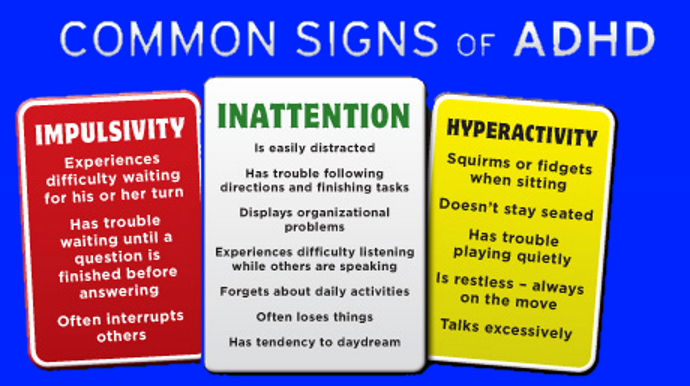ATTENTION DEFICIT HYPERACTIVITY DISORDER: 5 THINGS PARENTS AND TEACHERS NEED TO KNOW ABOUT IT
Attention deficit hyperactivity disorder is a childhood disorder that affects as many as one out of 10 children in the United States and More than 1.5 million cases per year in Nigeria. Even though it’s fairly common, many misconceptions still persist.
So here are five important things you should know if you are a parent or a teacher of a child with ADHD.
- The hallmark symptoms of ADHD are inattention, hyperactivity, and impulsivity. Most kids are inattentive, impulsive, and hyperactive at times. But for a diagnosis of ADHD, these symptoms must interfere significantly in multiple places, such as at school and at home. This is a childhood disorder, meaning the symptoms must be present before adolescence. The symptoms can start in preschool, but most kids aren’t diagnosed until later in childhood. People may experience:
Behavioural: aggression, excitability, fidgeting, hyperactivity, impulsivity, irritability, lack of restraint, or persistent repetition of words or actions
Cognitive: absent-mindedness, difficulty focusing, forgetfulness, problem paying attention, or short attention span
Mood: anger, anxiety, boredom, excitement, or mood swings
There are different types of ADHD: predominantly hyperactive/impulsive presentation; predominantly inattentive presentation; combined presentation. Most children with ADHD have a combination of inattention, impulsivity, and hyperactivity and would be diagnosed with ADHD-combined presentation. Other children who struggle most with hyperactivity and impulsivity would get the diagnosis of ADHD-hyperactive/impulsive presentation. A third group has predominantly problems with attention. While you often will hear these children described as ADD (attention deficit disorder), the correct term is ADHD-predominantly inattentive presentation. Girls tend to have inattentive symptoms more than boys.
ADHD is a brain-based disorder. Kids can’t overcome symptoms of ADHD by “trying to concentrate harder” or by willing themselves to “pay attention.” Brain imaging studies have shown that people with ADHD have structurally different brains than people without ADHD. It also runs in families. Children whose parents have ADHD have a 40% to 60% chance of also having ADHD. Sometimes a child’s diagnosis can be the first clue that a parent may have ADHD.
The symptoms of ADHD can make school, family, and social relationships difficult. School requires attention and organizational skills, things that can be difficult for kids with ADHD. They may lose homework, have difficulty organizing their thoughts, and have problems thinking ahead and planning. In addition, it’s common for children with ADHD to also have learning disabilities, such as dyslexia, that make schoolwork even more challenging. While kids with ADHD don’t generally have a specific problem with social skills, difficulty with emotion regulation and impulsivity can interfere with personal relationships, and so it can be hard for them to keep and maintain friendships. It can also be hard for them to follow social rules, control their emotions, or say the appropriate thing. Finally, problems with organization, planning, and focusing on what’s being said to them can make many aspects of home life quite difficult. Relationships with parents and siblings can take a lot more work.
There are great treatments available for children with ADHD. There are a variety of research-backed therapies that can help relieve symptoms of ADHD. Some of the most effective approaches combine several therapies, for example:
Medication: Many parents are fearful of trying medication, but ADHD medications are some of the most well-studied across all areas of medicine. Stimulant medications (such as Ritalin, Adderall, or Concerta) are the most commonly prescribed. These drugs stimulate the parts of the brain that are under-stimulated. These parts of the brain are related to thinking and attention. The goals of these medications are to reduce hyperactivity/impulsivity and increase focus/attention.
Behavior therapy: Behavior therapy teaches the child to be aware of, monitor, and eventually modify disruptive behaviors. The therapist will teach social skills, such as waiting your turn, reading facial expressions, sharing, asking for help, and reacting appropriately when teased. Cognitive behavioral therapy emphasizes mindfulness, and teaches a child to be aware of her thoughts and emotions as a way of improving attention and focus.
Education and training: Knowing oneself, or one’s child, can help parents understand how ADHD and its symptoms affect the family unit. Parents and teachers can learn tools that can help the child learn new, prosocial, and positive behaviors. Adults can learn how to cope with inappropriate behaviors and encourage positive ones. This can help reduce ADHD symptoms.
ADHD coaching: A coach can help students with ADHD work toward goals, see change as a positive thing, improve productivity and functioning, and keep a student accountable. This is particularly useful for older kids.
Article Credit: Harvard Health Blog.
Image credit: http://lifechangesgroup.com
